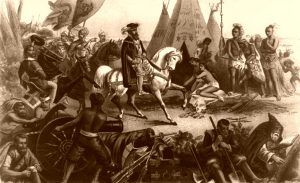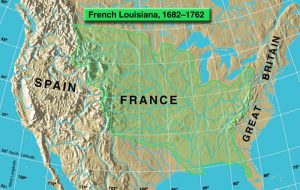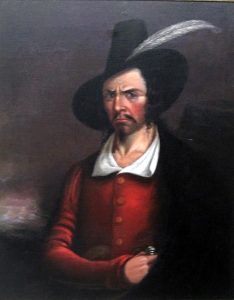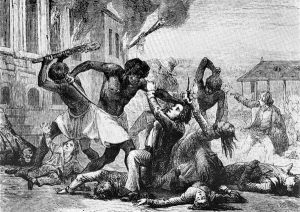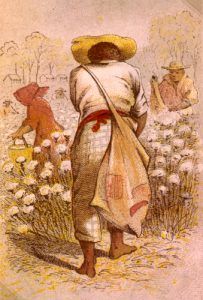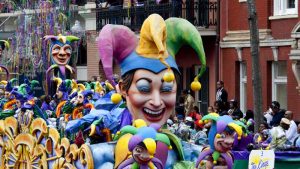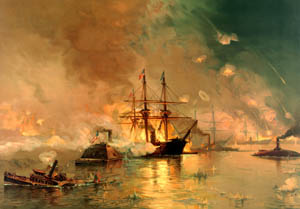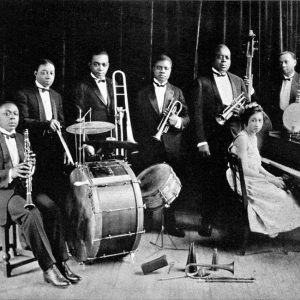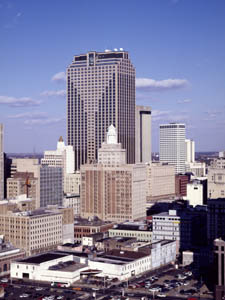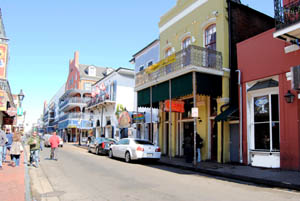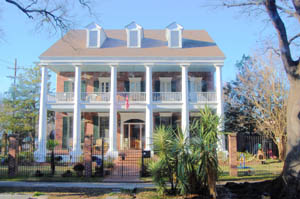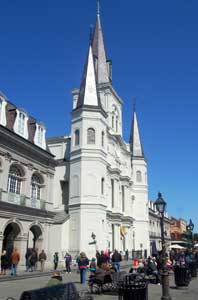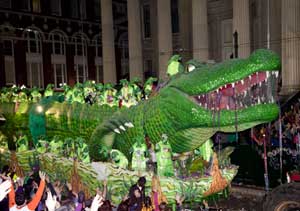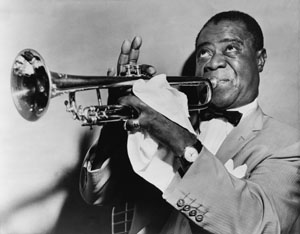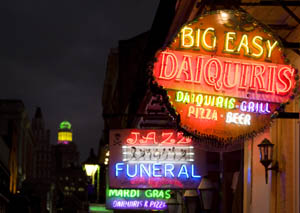
New Orleans Skyline by Carol Highsmith.
The historic city of New Orleans, Louisiana, is located along the Mississippi River in the southeastern part of the state. With its colonial French and Spanish character, this unique city is known for its annual Mardi Gras festival, jazz music, and flavorful Creole cuisine.
Before European exploration and settlement, many Indian tribes lived in Louisiana, including the Natchez, Atakapa, Caddo, Tunica, and others. These tribes, encompassing the Mississippi Valley and Gulf Coast region, ranged from small clans of hunters to large communities of farmers.
Spaniards were the first to venture into this region when Hernando de Soto led an expedition in 1542 along the Mississippi River. However, the climate and geography convinced Spain to look elsewhere for precious metals and fertile soil. Afterward, Louisiana was ignored for nearly a century and a half until France’s King Louis XIV began encouraging exploration of the mighty river to enlarge his empire and halt Britain’s and Spain’s expansion. In 1682, René-Robert Cavelier, Sieur de La Salle, reached the river’s mouth and proclaimed possession of the river and all the lands drained by it for France, naming this vast expanse “Louisiane,” or “Louis’ Land.”
Jean-Baptiste Le Moyne, Sieur de Bienville, continued to explore the Mississippi River and, in 1718, founded the city of New Orleans, named after the Duke of Orleans, who reigned as Regent for Louis XV from 1715 to 1723. Engineers laid out a grid of streets with a Place d’Armes at present-day Jackson Square, and the area is now known as the French Quarter. The city became the capital of the French Colony of Louisiana in 1723.
While a French colony, Louisiana was governed alternately by the crown and several chartered proprietors, who contracted with the crown for the colony’s administration and a trade monopoly in exchange for settlers and slaves to supply the colony with goods. Antoine Crozat was Louisiana’s first proprietor of Louisiana from 1712 until 1717.
When he resigned, the colony was turned over to John Law, who created the Company of the Indies corporation in 1719. However, the company was plagued by failed crops, Indian wars, slave insurrections, and financial disasters. The colony was then returned to the Crown of France, which administered it until 1763, when it was transferred to Spanish rule. It was transferred to keep it out of the hands of the British, who had won the French and Indian War.
Louisiana was a Spanish colony for the remainder of the 1700s and became an important trading and cultural partner with Cuba, Mexico, and beyond. During this time, New Orleans transformed from a village-like environment of wooden houses to a city of sturdier brick buildings with urban infrastructure, primarily due to slave labor.
The first settlers of New Orleans were French, Spanish, and African American. However, in later years, waves of immigrants would leave their mark on New Orleans culture, including Irish, Italian, and Germans.
The flow of goods between the Gulf of Mexico and the port of New Orleans also attracted smugglers, privateers, and pirates. Jean Lafitte and his brother Pierre were among the most infamous. The pair owned a blacksmith shop at 941 Bourbon Street that once served as the pirates’ base. Dating back to the 1770s, this is said to be the oldest structure housing a bar in the United States and is still a popular saloon today.
After two disastrous fires, in 1788 and 1794, new buildings were erected in a Spanish Colonial style, many of which featured wrought-iron balconies and courtyards. The Spanish also liberalized slavery policies that enabled the dramatic growth of a caste of free people of color.
In 1800, the Spanish transferred Louisiana back to France, and in 1803, it became part of the United States with the Louisiana Purchase. Although no longer a French colony, many residents continued to hold on to their French ways, including language, religion, customs, and social statuses.
In 1811, the largest slave revolt in the history of the United States erupted in Louisiana when a group of slaves launched their attack from a plantation upriver from New Orleans. Led by a Saint-Domingue slave named Charles Deslondes, the insurgents marched down River Road toward New Orleans, killing two whites, burning plantations and crops, and capturing weapons and ammunition.
In response, planters organized militiamen and vigilantes, reinforced with United States Army troops from Baton Rouge and New Orleans. The free black militia offered its services, and one company accepted. The two sides met outside New Orleans, and 66 slaves were killed in the revolt, with others missing or captured and held for trial. Only two whites were killed. Of the slaves tried, 21 were sentenced to death, shot, and decapitated, and their heads were placed on poles along the River Road to warn other potential rebel slaves.
On April 30, 1812, Congress admitted Louisiana as the 18th state in the Union.
In the 1820s, canals and later railroads linked the Northeast and the Upper Midwest more closely, which siphoned off trade from New Orleans. The Pontchartrain Railroad began operation in 1831 and was the second completed in the United States. The line carried passengers and goods between the Mississippi River and Lake Pontchartrain in New Orleans.
In 1840, New Orleans was the third-most populous city in the United States and the fourth-busiest port in the world. At that time, it had a population of 102,193. It would remain the largest city in the American South from the Antebellum era until after World War II.
By 1845, direct trade between the two northern regions of the United States was well established and broke the Louisiana River monopoly on western trade. However, increasing imports of southern cotton helped New Orleans retain its status as a leading antebellum port.
In the mid-1800s, the highest concentration of millionaires in the nation lived between New Orleans and Baton Rouge. Their wealth came mainly from sugar cane plantations, which depended on the labor of thousands of enslaved African Americans. In the 1850s alone, Louisiana plantations produced an estimated 450 million pounds of sugar annually, worth more than $20 million annually.
Amazingly, some of Louisiana’s most prosperous planters and farmers were free African Americans, among the wealthiest in the South. At that time, they owned more property than free blacks in any other state. Free blacks also played an important role in New Orleans’ economy. Many owned successful businesses or engaged in the professions and amassed substantial estates that included real, personal, and slave property.
Millions were made in commerce as sugar and cotton came downriver on steamboats en route to global markets. The wealth spread from the plantations to bankers, merchants, insurers, and lawyers who managed finance and logistics. This wealth can still be seen today in the magnificent mansions and the opulent townhouses of the French Quarter.
Mardi Gras had been celebrated with the first French colonists and later with public festivals and private costumed balls. However, it was generally an informal affair until 1857, when a group introduced formal parades and elaborate floats. Since then, Mardi Gras parades and festivals have become an annual tradition.
On January 26, 1861, Louisiana became the sixth state to secede from the Union. When the Civil War officially began just a few months later, the Mississippi River and the Louisiana coastline became strategic factors for both sides. It was also important as a thoroughfare to move military supplies such as munitions, foodstuffs, clothing, and livestock. Goods from Mexico and Texas flowed eastward and northward along Louisiana railroads and rivers into other Confederate states.
However, New Orleans’ fight for the Confederate cause would be short-lived as Union troops captured the city in May 1862 and occupied the region for the remainder of the Civil War. When the war was over, the Reconstruction-era government passed a progressive state constitution and sought to establish civil rights for emancipated slaves. But when Reconstruction ended in 1877, white supremacist forces steadily regained control, and racial subjugation and segregation would ensue for a century.
Afterward, New Orleans would never regain its domination of the western trade, but as time passed, it caught up with railroad construction, port modernization, levee-building, and urban improvements.
Arts and performance flourished by the late 19th century, and notable buildings were erected, including hundreds of ornate gingerbread-adorned houses.
By 1900, jazz had emerged, and New Orleans was thriving as a major sea and river port and as a major entertainment center. Legitimate theater, vaudeville, music publishing houses, and instrument stores employed musicians in the central business district. Less legitimate entertainment establishments also flourished in and around Storyville’s officially sanctioned red-light district near Canal and Rampart streets. Out on the shores of Lake Ponchartrain, bands competed for audiences at amusement parks and resorts. Street parades were common in the neighborhood, and community social halls and corner saloons held dances almost nightly.
When World War II began, New Orleans played a critical role in the struggle. Local shipbuilder Andrew Higgins, who had designed unique vessels to navigate the shallow Louisiana bayous, realized they would serve well to deliver soldiers and equipment onto shallow beaches while avoiding deep-water harbors in enemy hands.
Built in local shipyards, “Higgins Boats” were used on the beaches of Normandy on D-Day and throughout the island-hopping campaign in the Pacific. They were so successful that General Dwight D. Eisenhower would describe Higgins as “the man who won the war for us.”
When the war was over, new bridges and highways were built to access the expanding suburbs, and new modern skyscrapers began to break the city’s formerly modest skyline.
In the 1960s, the Civil Rights movement brought dignity and new opportunities to many African Americans living in New Orleans. However, as in other places, resistance to school integration, white flight, and a reduced tax base left some inner-city neighborhoods impoverished and divested.
In the early 1980s, the area experienced an oil bust that coincided with the mechanization of port activity and the decline of well-paying shipping jobs. This led to a regional recession and population exodus. By the late 1990s, however, an increasingly robust tourism sector and a more diversified economy helped mitigate the losses.
New Orleans remains a city of rich culture, proud people, and historic neighborhoods. New Orleans also has more than 35,000 buildings listed on the National Register of Historic Places, more than any other city in the nation.
With its motto of “Laissez les bons temps rouler (Let the good times roll),” it is also known for its parties and festivities, such as Mardi Gras, marked by parades, costumes, and colorful beads. It is world-renowned for its distinct music, Creole cuisine, unique dialect, swampy Southern charm, and spooky intrigue.
The city’s historic heart is the French Quarter, known for its French and Spanish Creole architecture and vibrant nightlife along Bourbon Street. Here, Preservation Hall, a famous jazz club, popular bars and restaurants on Bourbon Street, and Café du Monde, where New Orleans-style coffee blended with chicory has been served since 1862, can be found.
Throughout the city, visitors enjoy Creole cuisine, which is a blend of the city’s various cultures, including African, French, Irish, Italian, Spanish, German, Caribbean, Native American, and Portuguese.
And… New Orleans is said to be the most haunted city in the United States. It has been known for its ghost sightings, haunted buildings, and gruesome tales for years. The city is so rich with dark secrets and lore that it has become an essential part of New Orleans’ character.

The St. Louis Cemeteries in New Orleans are called the Cities of the Dead by the Detroit Publishing Company, 1901.
New Orleans has several nicknames, including Crescent City, which alludes to the course of the Lower Mississippi River around and through the city. Also called the Big Easy, which is probably a reference by musicians in the early 20th century to the relative ease of finding work there.
Today, New Orleans is called home to about 390,000 people, making it the most populous city in Louisiana. It continues to serve as a major port and is an economic and commercial hub for the broader Gulf Coast region of the United States.
Key dates in New Orelans’ history:
1682 – On April 9, French explorer Robert Cavelier, Sieur de La Salle, arrives at the mouth of the Mississippi River and claims the region for France.
1699 – Pierre Le Moyne, Sieur d’Iberville, establishes the French colony of Louisiana.
1718 – Jean Baptiste Le Moyne, Sieur de Bienville, founds the city of New Orleans.
1723 – New Orleans becomes the capital of the Louisiana colony.
1763 – On February 10, the Treaty of Paris was signed, ending the Seven Years’ War and resulting in Spain taking possession of New Orleans from France.
1788 – On March 21, a large fire swept through New Orleans, destroying over 850 buildings.
1800 – On October 1, after the secret Treaty of San Ildefonso was signed, France reacquired Louisiana from Spain.
1803 – On April 30, the United States purchased the Louisiana Territory from France for about $15 million. The acquisition doubled the size of the United States.
1812 – On April 30, Louisiana was admitted to the Union.
1814 – British forces are defeated in the Battle of New Orleans at New Orleans. It is the last battle of the War of 1812.
1835 – On March 3, Congress authorized a U.S. Mint in New Orleans.
1838 – The first Mardi Gras parade is held.
1840s – L’Album Littéraire, Louisiana’s first literary magazine, is founded by French-speaking African-American poets and writers.
1853 – New Orleans suffers its worst yellow fever epidemic, killing approximately 9,000 people.
1857 – Mardi Gras, in its modern form, debuts in New Orleans with the establishment of the parading organization called the “Mistick Krewe of Comus.”
1861 – On January 26, Louisiana seceded from the Union. The Civil War began just a few months later, on April 12.
1862 – Union forces capture New Orleans from the Confederacy, and the city is spared the destruction suffered by many other cities in the American South.
1868 – In April, Louisiana’s Reconstruction government approved a Constitution that extended voting rights to black males and integrated public schools and public accommodations. A few months later, on June 25, Louisiana was readmitted to the Union.
1901 – Famous jazz performer Louis Armstrong was born in New Orleans and developed his talents growing up in poor sections of the city.
1905 – Yellow fever strikes New Orleans for the final time, killing more than 400 people.
1929 – A local restaurant creates the New Orleans sandwich known as a po’boy to provide free food to strikers.
1970 – On January 11, New Orleans hosts its first Super Bowl. The city has hosted the National Football League championship game nine times.
1975 – The Superdome, the largest fixed dome structure in the world, opens in New Orleans.
2005 – On August 29, Hurricane Katrina landed on the Louisiana coast. Levees are breached in New Orleans, flooding portions of the city. The hurricane killed more than 1,600 people, and many thousands remain displaced.
© Kathy Alexander/Legends of America, updated January 2024.
Also See:
Haunted Cities of the Dead – New Orleans
Jean Lafitte – A “Hero” Pirate
Sources:
Bureau of Global Public Affairs
City of New Orleans
Lousiana Department of Culture, Recreation & Tourism
National Park Service
Wikipedia

